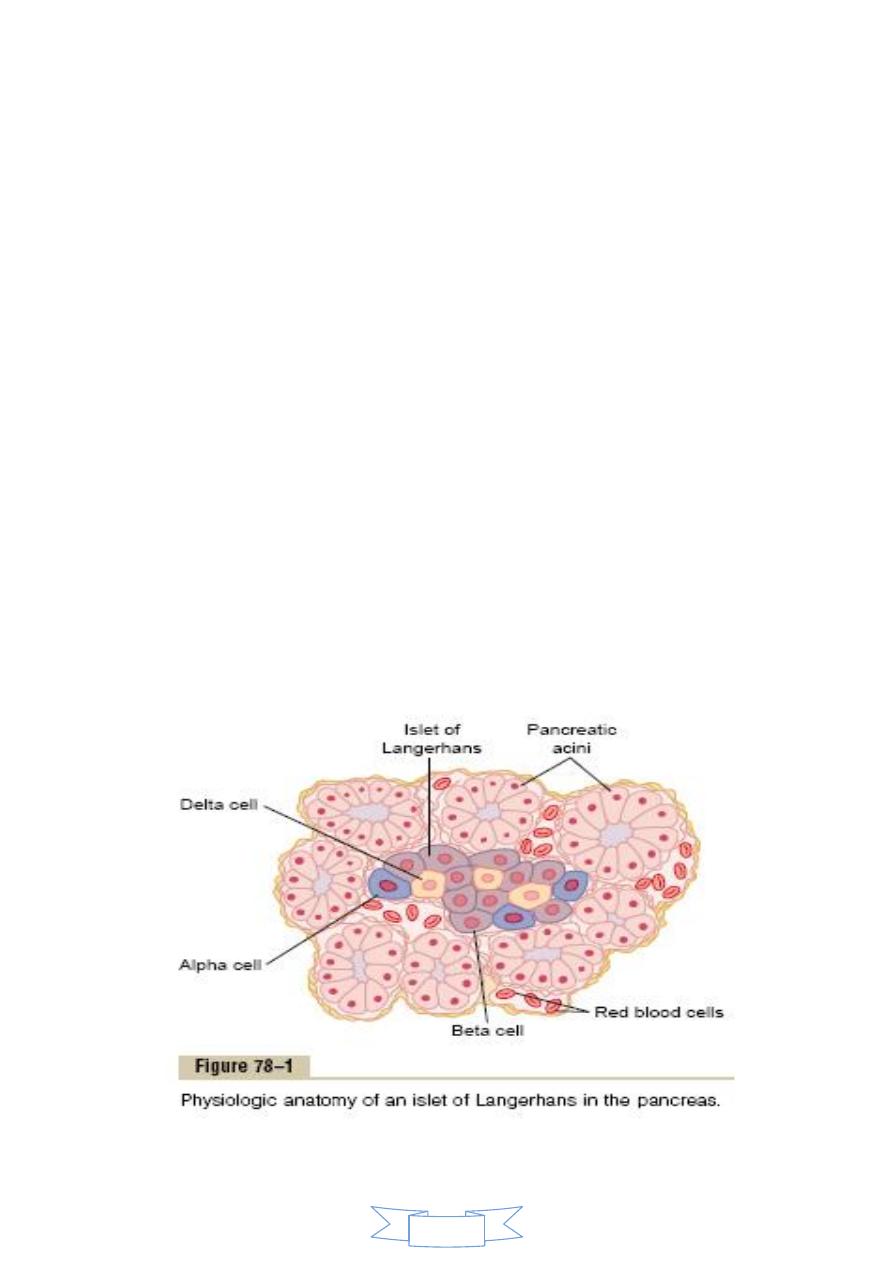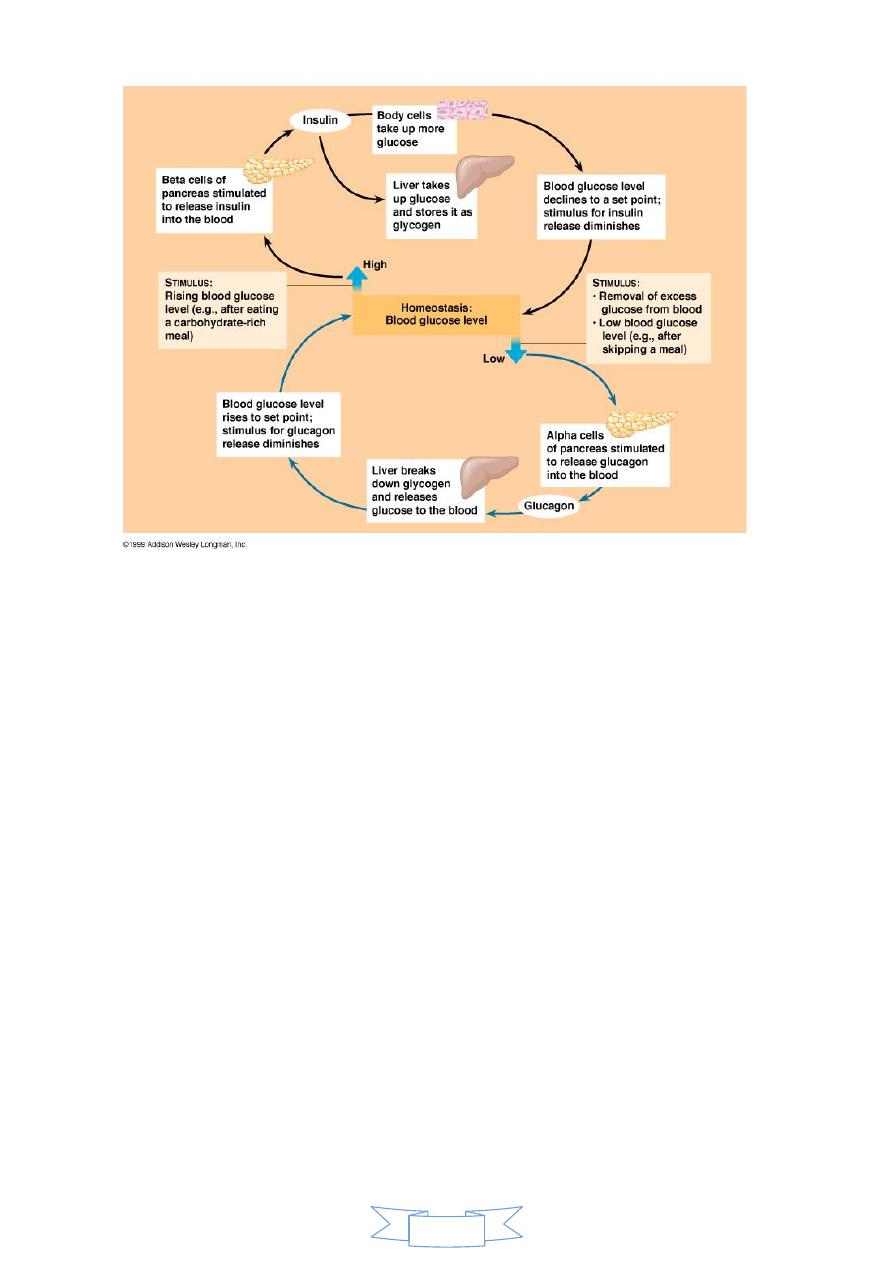
1
Dr. Sajeda Al-Chalabi
PHYSIOLOGY OF THE ENDOCRINE SYSTEM
Pancreas
• The pancreas is a nodular organ occupying a space between the stomach &
small intestine. It contains both exocrine & endocrine cells. The exocrine
pancreas secretes an enzyme-rich fluid into the lumen of the digestive
tract. Cells of the endocrine pancreas form clusters called pancreatic islets
(islets of Langerhans).
• Each islet contains 4 cell types:
– alpha cells produce glucagon;
– beta cells secrete insulin
– delta cells secrete somatostatin (growth hormone-inhibiting factor).
– F- cells secrete pancreatic polypeptide.(10% of the cells).
– Β- cells account for 60-75% of the cells in the islet.
– Α- cells account for 20% of cells of islet.

2
Insulin and its metabolic effects
Insulin was first isolated from the pancreas in 1922 .
It is a small protein , has a molecular weight of 5808 .
It is composed of two amino acid chains connected to each other by disulfide
linkages .
Insulin is synthesized in the beta cells , when insulin is secreted in the blood , it
circulates in an unbound form , it has a plasma half life about 6 minutes , so that
it is cleared from the circulation within 10-15 minutes .
Insulin is degraded by the enzyme insulinase mainly in the liver & to a lessor
extent in the kidneys & muscles , except that portion of insulin that combines
with receptors in the target cells.
Effect of Insulin on Carbohydrate Metabolism
1. Insulin Promotes Muscle Glucose Uptake and Metabolism
of
One
under two conditions the muscles do use large amounts of glucose.
these is during moderate or heavy exercise.This usage of glucose does not
require large amounts of insulin, because exercising muscle fibers become
more permeable to glucose even in the absence of insulin because of the
contraction process itself.
condition for muscle usage of large amounts of glucose is during
second
The
the few hours after a meal. At this time the blood glucose concentration is
high and the pancreas is secreting large quantities of insulin. The extra insulin
causes rapid transport of glucose into the muscle cells.
2.Insulin Promotes Liver Uptake, Storage, and Use of Glucose
One of the most important of all the effects of insulin is to cause most of the
glucose absorbed after a meal to be stored almost immediately in the liver in
the form of glycogen. Then, between meals, when food is not available and

3
the blood glucose concentration begins to fall, insulin secretion decreases
rapidly and the liver glycogen is split back into glucose, which is
released back into the blood to keep the glucose concentration from falling
too low.
Lack of Effect of Insulin on Glucose Uptake
and Usage by the Brain
The brain is quite different from most other tissues of the body in that insulin
has little effect on uptake or use of glucose. Instead, the brain cells are
permeable to glucose and can use glucose without the intermediation of insulin.
Effect of Insulin on Fat Metabolism
Insulin Promotes Fat Synthesis and Storage
Insulin has several effects that lead to fat storage in adipose tissue. First, insulin
increases the utilization of glucose by most of the body’s tissues, which
automatically decreases the utilization of fat, thus functioning as a fat sparer.
However, insulin also promotes fatty acid synthesis. This is especially true when
more carbohydrates are ingested than can be used for immediate energy, thus
providing the substrate for fat synthesis.
Effect of Insulin on Protein
Metabolism and on Growth
Insulin Promotes Protein Synthesis and Storage
1. Insulin stimulates transport of many of the amino
acids into the cells.
2.Insulin increases the translation of messenger RNA, thus forming new proteins.
3.Insulin inhibits the catabolism of proteins, thus decreasing the rate of amino
acid release from the cells, especially from the muscle cells.

4
4.In the liver, insulin depresses the rate of gluconeogenesis. It does this by
decreasing the activity of the enzymes that promote gluconeogenesis.
Control of Insulin Secretion
Increased Blood Glucose Stimulates Insulin Secretion
At the normal fasting level of blood glucose of 80 to 90 mg/100 ml, the rate of
insulin secretion is minimal
•
If the blood glucose concentration is suddenly increased to a level
two to three times normal and kept at this high level thereafter, insulin
secretion increases markedly in two stages
1. Plasma insulin concentration increases almost 10-fold within 3 to 5 minutes
after the acute elevation of the blood glucose; this results from immediate
dumping of preformed insulin from the beta cells of the islets of Langerhans.
However, the initial high rate of secretion is not maintained; instead, the insulin
concentration decreases about halfway back toward normal in another 5 to 10
minutes.

5
2. Beginning at about 15 minutes, insulin secretion rises a second time and
reaches a new plateau in 2 to 3 hours, this time usually at a rate of secretion
even greater than that in the initial phase. This secretion results both from
additional release of preformed insulin and from activation of the enzyme
system that synthesizes and releases new insulin from the cells.
Glucagon and its function
Is a hormone secreted by the alpha cells of the islet of langerhans when the
blood glucose concentration falls , has several functions that opposed to those
of insulin . Most important of these functions is to increase the blood glucose
concentration .
Glucagon is a large polypeptide , is composed of 29 amino acids . glucagon is
also called the hyperglycemic hormone.
Effect of glucagon on glucose metabolism
The major effects of glucagon on glucose metabolism are:-
1. Breakdown of liver glycogen ( glycogenolysis ).

6
2. Increased gluconeogenesis in the liver .
Both of these effects enhance the availability of glucose to the other organs of
the body .
Other effects of glucagon occur only when its concentration rises well above the
maximum normally found in blood. The most important effect is that glucagon
activates adipose cell lipase , making increased quantities of fatty acids .
Glucagon in very high concentration also :-
1. Enhance the strength of the heart .
2. Increase blood flow in some tissues .
3. Enhances bile secretion .
4. Inhibit gastric acid secretion .
Regulation of glucagon secretion
1. Increase blood glucose inhibits glucagon secretion :
the blood glucose concentration is the most potent factor that
controls glucagon secretion . That the effect of blood glucose
concentration on glucagon secretion is exactly the apposite direction from
the effect of glucose on insulin secretion
.
The decrease in the blood glucose concentration to hypoglycemic levels
can increase the plasma concentration of glucagon several fold ,
conversely the blood glucose to hyperglycemic levels decreases plasma
glucagon.
2. Increased blood amino acids stimulate glucagon secretion , it is the
same effect on insulin secretion .
glucagon promotes rapid conversion of amino acids to glucose .
3. Exercise stimulates glucagon secretion , in exhaustive exercise , the
blood concentration of glucagon increase four fold to five fold .

7
Somatostatin inhibits glucagon & insulin secretion
The delta cells of the islet of Langerhans secrete somatstatin , which is a
polypeptide containing 14 amino acids , it has short half life of 3 minutes .
Almost all factors related to the ingestion of food stimulate somatostatin
secretion .
They include :
1. Increased blood glucose .
2. increased amino acids .
3. Increased fatty acids .
4. Increased concentrations of several of G.I.T. hormones.
In turn , somatostatin has multiple inhibitory effects :
1. somatostatin acts locally within the islets of Langerhans themselves to
decrease the secretion of both insulin & glucagon .
2. somatostatin decreases the motility of the stomach , dudenum &
gallbladder .
3. it decreases both secretion & absorption in the G.I.T.

8
Diabetes Mellitus
Diabetes mellitus is a syndrome of impaired carbohydrate, at, and protein
metabolism caused by either lack of insulin secretion or decreased
sensitivity of the tissues to insulin. There are two general types of diabetes
mellitus:
1. Type I diabetes, also called insulin-dependent diabetes mellitus (IDDM),
is caused by lack of insulin secretion.
2. Type II diabetes, also called non–insulin-dependent diabetes mellitus
(NIDDM), is caused by decreased sensitivity of target tissues to the
metabolic effect of insulin. This reduced sensitivity to insulin is often called
insulin resistance
In both types of diabetes mellitus, metabolism of all the main foodstuffs is
altered.The basic effect of insulin lack or insulin resistance on glucose
metabolism is to prevent the efficient uptake and utilization of glucose by

9
most cells of the body, except those of the brain. Asa result, blood glucose
concentration increases, cell utilization of glucose falls increasingly lower,
and utilization of fats and proteins increases.
Pineal Gland
• Secrets one hormone only : Melatonin
• Involved in your circadian rhythm (your recognition of day and night )
• -- Melatonin secretion decreases in the day
• -- Melatonin secretion increases in the night
• Melatonin is thought to be involved in the female monthly cycle and may
be in the onset of puberty
@RamiQays
